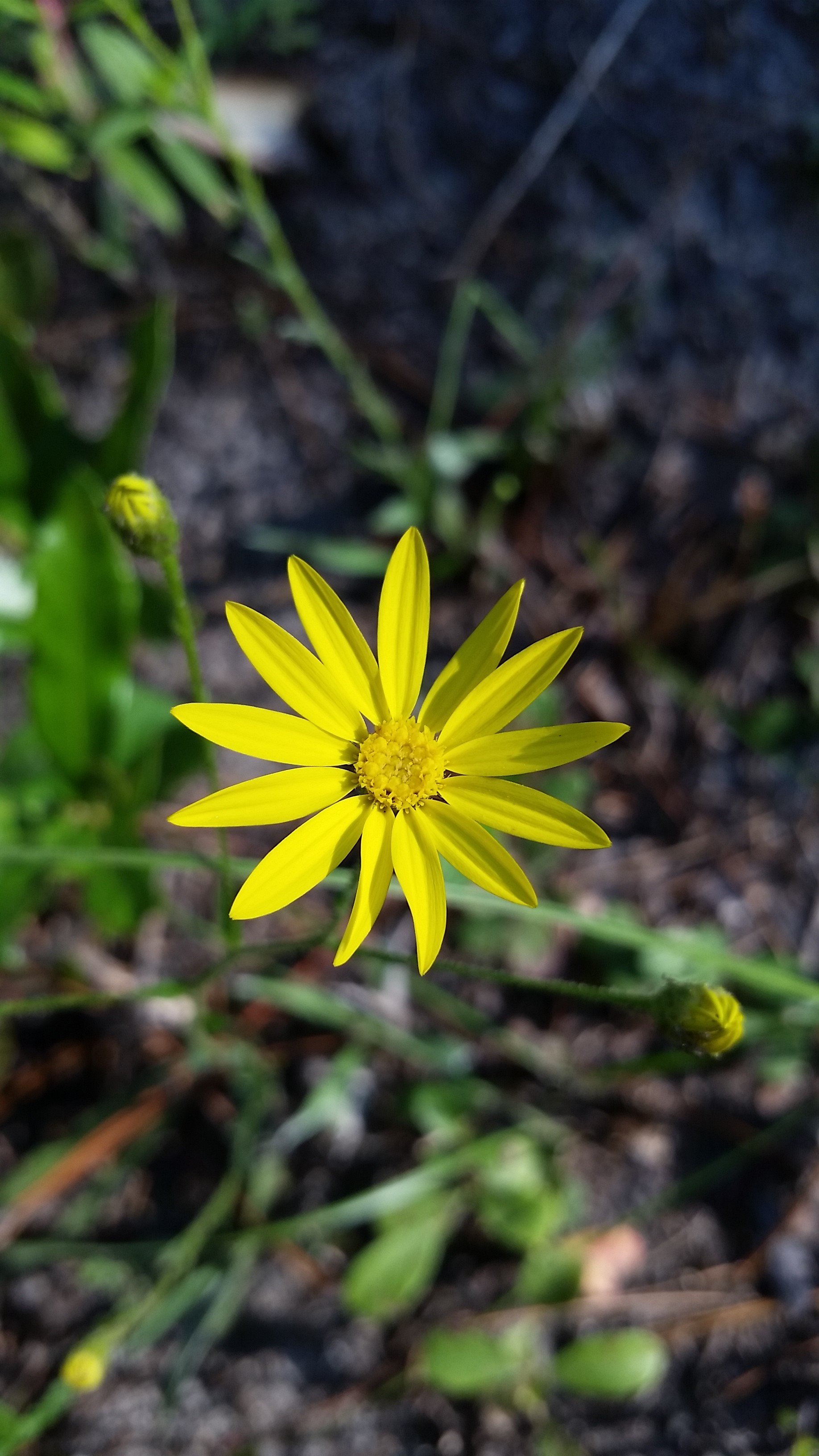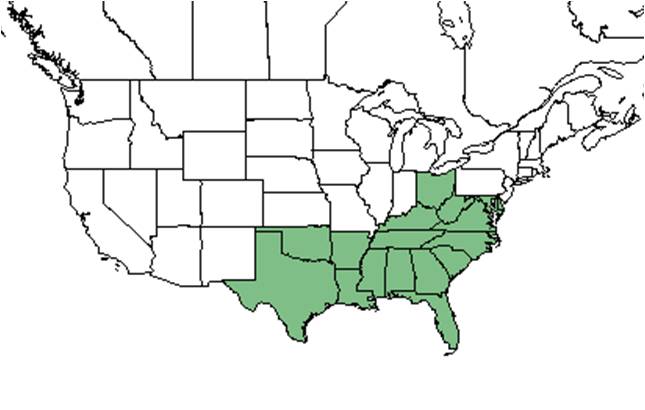Pityopsis graminifolia
| Pityopsis graminifolia | |
|---|---|

| |
| Photo by Michelle Smith | |
| Scientific classification | |
| Kingdom: | Plantae |
| Division: | Magnoliophyta - Flowering plants |
| Class: | Magnoliopsida – Dicotyledons |
| Order: | Asterales |
| Family: | Asteraceae |
| Genus: | Pityopsis |
| Species: | P. graminifolia |
| Binomial name | |
| Pityopsis graminifolia (Michx.) Nutt. | |

| |
| Natural range of Pityopsis graminifolia from USDA NRCS Plants Database. | |
Common name: Narrowleaf silkgrass
Contents
Taxonomic notes
Synonyms: Chrysopsis graminifolia (Michaux) Elliott var. graminifolia; Chrysopsis graminifolia (Michaux) Elliott var. microcephala (Small) Cronquist; Heterotheca nervosa (Willdenow) Shinners var. microcephala (Small) Shinners ex H.E. Ahles;Heterotheca microcephala (Small) Shinners var. microcephala; 'Pityopsis microcephala (Small) Small.[1]
Varieties:Pityopsis graminifolia (Michaux) Nuttall var. tenuifolia (Torrey) Semple & F.D. Bowers; Pityopsis graminifolia (Michaux) Nuttall var. latifolia Fernald; Pityopsis graminifolia (Michaux) Nuttall var. graminifolia;
Description
Pityopsis graminifolia is a cepitose, sericeous-floccose perennial with an erect, 4-8 dm tall stem and appressed or ascending leaves. The leaves are linear, grass-like, and entire. They are basal parallel-veined, 1-3.5 dm long and 3-10 mm wide. The heads number three to many and grow in corymbs. The involucres are cylindric to campanulate, 7-8 mm long, and 5-8 mm broad. The bracts are linear, appressed, and stipitate-glandular. The rays are numbered 4-10 and 1-1.5 cm long. The nutlets are reddish-brown to black, fusiform, pubescent, and 2.3-3 mm long. The pappus is colored tan to cinnamon and 4.5-6 mm long.[1]
Pityopsis graminifolia does not have specialized underground storage units apart from its fibrous roots.[2] Diaz-Toribio and Putz (2021) recorded this species to have a water content of 58.6% (ranking 65 out of 100 species studied).[2]
Distribution
Ecology
Habitat
Pityopsis graminifolia is restricted to native groundcover with a statistical affinity in upland pinelands of South Georgia.[3] This species is considered an indicator of non-agriculture history in frequently burned longleaf pine habitats.[4]
However, P. graminifolia responds positively to agricultural-based soil disturbance in South Carolina coastal plain communities. This marks it as a possible indicator species for post-agricultural woodland.[5] P. graminifolia responds negagively to soil disturbance by heavy silvilculture in North Carolina.[6] When exposed to soil disturbance by military training in West Georgia, P. graminifolia responds negatively by way of absence.[7] It exhibits no response to soil disturbance by clearcutting, bracke seeding, single roller chopping, broadcast seeding, high-severity burns, and salvage logging in Central Florida.[8] P. graminifolia responds negatively to soil disturbance by roller chopping in Northwest Florida sandhills,[9] negatively or not at all to soil disturbance by roller chopping in South Florida,[10] and positively to soil disturbance by clearcutting and roller chopping in North Florida.[11] However, it does not respond to soil disturbance by clearcutting and chopping in North Florida flatwoods forests.[12]
Pityopsis graminifolia is frequent and abundant in the Peninsula Xeric Sandhills, North Florida Subxeric Sandhills, Clayhill Longleaf Woodlands, Panhandle Silty Longleaf Woodlands, Xeric Flatwoods, North Florida Mesic Flatwoods, Central Florida Flatwoods/Prairies, and Upper Panhandle Savannas community types as described in Carr et al. (2010).[13]
Phenology
P. graminifolia has been observed flowering in January, April, May, July, and from September to December.[14]
Seed dispersal
This species disperses by wind.[15]
Fire ecology
May or may not show fire-stimulated flowering, depending on variety or ecotype.[16] [17] [18]
Pollination
The following Hymenoptera families and species were observed visiting flowers of Pityopsis graminifolia at Archbold Biological Station.[19]
Andrenidae: Andrena fulvipennis
Apidae: Bombus impatiens, Epeolus pusillus, Nomada fervida
Colletidae: Colletes mandibularis
Halictidae: Agapostemon splendens, Augochlora pura, Augochlorella aurata, Augochloropsis anonyma, A. metallica, A. sumptuosa, Halictus poeyi, Lasioglossum miniatulus, L. nymphalis, L. pectoralis, L. placidensis
Leucospididae: Leucospis robertsoni
Megachilidae: Anthidiellum notatum rufomaculatum, A. perplexum, Anthidium maculifrons, Coelioxys octodentata, C. sayi, C. texana, Dianthidium floridiense, Megachile albitarsis, M. brevis pseudobrevis, M. georgica, M. inimica, M. mendica, M. petulans, M. pruina
Sphecidae: Bicyrtes capnoptera, Cerceris tolteca, Philanthus ventilabris, Prionyx thomae, Trypargilum clavatum johannis
Vespidae: Parancistrocerus salcularis rufulus, Stenodynerus beameri
Use by animals
Buds fed upon by white-tailed deer.[20] Common grasshoppers, including Melanopus angustipennis as well as grasshoppers in the subfamilies Melanoplinae and Cyrtacanthacridinae, are mixed feeders and often feed on Pityopsis graminifolia. This plant is quite susceptible to herbivory, but overall herbivory has weak effects on biomass and mortality.[4]
Conservation, cultivation, and restoration
Cultural use
Photo Gallery
References and notes
- ↑ 1.0 1.1 Weakley, A.S. 2015. Flora of the southern and mid-atlantic states. Working Draft of 21 May 2015. University of North Carolina at Chapel Hill, Chapel Hill, North Carolina.
- ↑ 2.0 2.1 Diaz-Toribio, M.H. and F. E. Putz 2021. Underground carbohydrate stores and storage organs in fire-maintained longleaf pine savannas in Florida, USA. American Journal of Botany 108: 432-442.
- ↑ Ostertag, T.E., and K.M. Robertson. 2007. A comparison of native versus old-field vegetation in upland pinelands managed with frequent fire, South Georgia, USA. Pages 109–120 in R.E. Masters and K.E.M. Galley (eds.). Proceedings of the 23rd Tall Timbers Fire Ecology Conference: Fire in Grassland and Shrubland Ecosystems.
- ↑ 4.0 4.1 Hahn, P. C. and J. L. Orrock (2015). "Land-use legacies and present fire regimes interact to mediate herbivory by altering the neighboring plant community." Oikos 124: 497-506.
- ↑ Brudvig, L.A., E Grman, C.W. Habeck, and J.A. Ledvina. (2013). Strong legacy of agricultural land use on soils and understory plant communities in longleaf pine woodlands. Forest Ecology and Management 310: 944-955.
- ↑ Cohen, S., R. Braham, and F. Sanchez. (2004). Seed Bank Viability in Disturbed Longleaf Pine Sites. Restoration Ecology 12(4):503-515.
- ↑ Dale, V.H., S.C. Beyeler, and B. Jackson. (2002). Understory vegetation indicators of anthropogenic disturbance in longleaf pine forests at Fort Benning, Georgia, USA. Ecological Indicators 1(3):155-170.
- ↑ Greenberg, C.H., D.G. Neary, L.D. Harris, and S.P. Linda. (1995). Vegetation Recovery Following High-intensity Wildfire and Silvicultural Treatments in Sand Pine Scrub. American Midland Naturalist 133(1):149-163.
- ↑ Hebb, E.A. (1971). Site Preparation Decreases Game Food Plants in Florida Sandhills. The Journal of Wildlife Management 35(1):155-162.
- ↑ Lewis, C.E. (1970). Responses to Chopping and Rock Phosphate on South Florida Ranges. Journal of Range Management 23(4):276-282.
- ↑ Lewis, C.E., G.W. Tanner, and W.S. Terry. (1988). Plant responses to pine management and deferred-rotation grazing in north Florida. Journal of Range Management 41(6):460-465.
- ↑ Moore, W.H., B.F. Swindel, and W.S. Terry. (1982). Vegetative Response to Clearcutting and Chopping in a North Florida Flatwoods Forest. Journal of Range Management 35(2):214-218.
- ↑ Carr, S.C., K.M. Robertson, and R.K. Peet. 2010. A vegetation classification of fire-dependent pinelands of Florida. Castanea 75:153-189.
- ↑ Nelson, G. PanFlora: Plant data for the eastern United States with emphasis on the Southeastern Coastal Plains, Florida, and the Florida Panhandle. www.gilnelson.com/PanFlora/ Accessed: 12 DEC 2016
- ↑ Kirkman, L. Katherine. Unpublished database of seed dispersal mode of plants found in Coastal Plain longleaf pine-grasslands of the Jones Ecological Research Center, Georgia.
- ↑ Brewer J.S. 1995. The relationship between soil fertility and fire-stimulated floral induction in two populations of grass-leaved golden aster, Pityopsis graminifolia. Oikos 74:45-54.
- ↑ Brewer, J. S. 2009. Geographic variation in flowering responses to fire and season of clipping in a fire-adapted plant. American Midland Naturalist 160:235-249.
- ↑ Gowe, A.K. and J. S. Brewer. 2005. The evolution of fire-dependent flowering in goldenasters (Pityopsis spp.). Journal of the Torrey Botanical Society 132:384-400.
- ↑ Deyrup, M.A. and N.D. 2015. Database of observations of Hymenoptera visitations to flowers of plants on Archbold Biological Station, Florida, USA.
- ↑ Brewer J.S. and Platt W.J. 1994. Effects of fire season and herbivory on reproductive success of a clonal forb, Pityopsis graminifolia. Journal of Ecology 82:665-675.